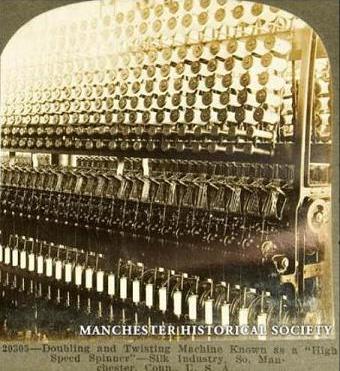



Silk Industry, So. Manchester, Conn., U.S.A.
The machine here shown is called a "high speed spinner." It performs the operations of doubling and twisting at the same time. Contrary to the arrangement shown in the doubling machine in the preceding view, the bobbins containing the threads to be doubled are placed on the upper part of the rack. The threads from these bobbins are carried down over the machine to the spindles on the lower part. These spindles revolve and twist the threads as they wind them off from the first set of bobbins.
There are three chief kinds of thrown silk, resulting from the quality of the raw silk and various kinds of throwing operations performed. The first class is known as "singles." These are made by the twisting of a single raw silk strand from the filaments of eight or ten cocoons. The second class includes "weft thread," which is made from the doubling, without any twisting, of two or three strands of raw silk. The third class, known as "organzine," includes the thread used for warps. It is made from several strands which have been spun in the direction opposite to that in which they have been twisted. From the weft are obtained the cross threads of very fine fabrics, whereas the threads running lengthwise in a piece of cloth are derived from warps.

 )
)